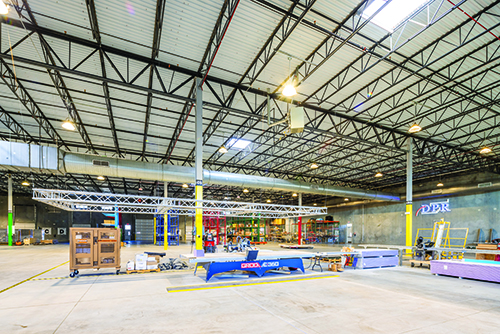Training programs are good long-term solutions, but factories also need to fill their current staffing needs. Here are some ideas.
- Staffing agencies are a way for factories get the workers they need without the administrative burden.
- Construction training programs that aren’t offsite-specific can still be tapped by offsite companies.
- With competition for workers high, smart companies are taking steps to make themselves attractive places to work.
By now, pretty much everyone has the talking points on today’s major industry issues. There’s a housing shortage, in general, and a lack of affordable housing, in particular. And there is wide recognition that offsite construction has the potential to help alleviate those issues.
But finding workers to staff offsite factories can be a challenge. According to the Modular Building Institute’s annual report, the modular industry captured 6.64% of new construction starts in 2023, up from 5% in 2020. The industry is growing, even if incrementally. Offsite manufacturers need workers, and they need those workers now.
While training programs for high schoolers and middle schoolers are a good start, that could be a four- to eight-year runway. Is there “low hanging fruit”— i.e. more immediate workforce solutions — that could provide training for offsite construction?
The answer is that while the labor issue will likely persist, a variety of companies, organizations and internal changes have the potential to help alleviate workforce issues sooner rather than later.
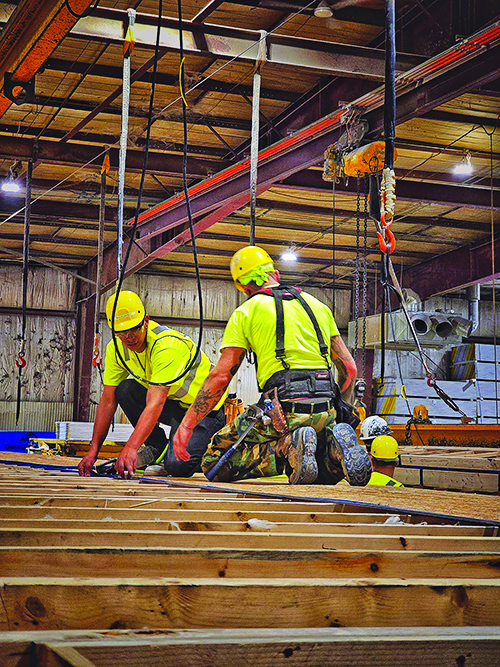
Credit: Courtesy of FourA Constructs
Subcontract Factory Workers
FourA Constructs (FourA), based in Atlanta, Georgia, provides skilled workers to manufactured home and modular manufacturers. Company owner Trey Shelton has several hundred people on his payroll and accounts with factories and jobsites in Pennsylvania, Minnesota, Indiana, Texas, Tennessee, North and South Carolina, Georgia, Florida, Utah and Arizona. “We work in stick-built factories. We work in light-gauge steel factories. We work in single-family, multifamily, hospitality,” says Shelton, who considers himself a vendor or subcontractor for the manufacturer.
In 2012, Shelton was a general contractor in Atlanta when he got a call from a South Carolina modular factory doing multifamily projects. “They couldn’t find the right skilled labor force,” he says, and they wanted some help. “They knew I had plenty of skilled labor and that I had a background in staffing.” He visited the factory and decided that the work looked easier than what he and his people were doing with sticks and bricks on-site.
Shelton shopped around for workers, pulling subcontractors from his own trade partner bases and from jobsites. Ultimately, he says, he “put 130 people into that factory and my crewstarted pushing out anywhere between 30,000 to 40,000 sq. ft. a week in modules.” Other modular manufacturers soon came calling.
To encourage people to work for FourA, Shelton tells prospective employees they will have consistent work, competitive pay, job security, get to work inside when it’s hot or cold, and work in an environment with quality control. “And all work is monitored by a third-party inspection adhering to all current building practices and codes for the final destination of the building,” he says.
His ideal employee/job candidate is someone who’s been in the construction world for a few years. “They want to work hard and are proud of what they do and proud of what they make. They may not have every construction skill in the world, but we can teach that,” Shelton says.
Workers are trained on the job and get paid by FourA for it. “I put people in factories and tell my clients, ‘I’m not billing for them during training,’” Shelton says. “They’re simply working alongside my own specially trained workforce to learn their trades and learn the production floor.” He pays employees a competitive wage, including health insurance and other benefits. In addition, he pays for housing, since his employees move from one state to another as they’re hired for individual projects.
Most of Shelton’s employees remain in one factory for many years but are not bound to it. “If there are layoffs or a shut down, they can go elsewhere,” he explains. “Turnover for us is very low since we can relocate the employee to a different factory to perform the trade they were trained to do.”
Says Shelton, “Hiring’s a big issue for most manufacturers that we meet with. They find it much simpler for us to say, ‘Hey, we’ll feed you 20 people that have worked in factories for years, that know what they’re doing. You don’t have to interview anymore. They’ll get on your floor. It’ll be a seamless transition.’”
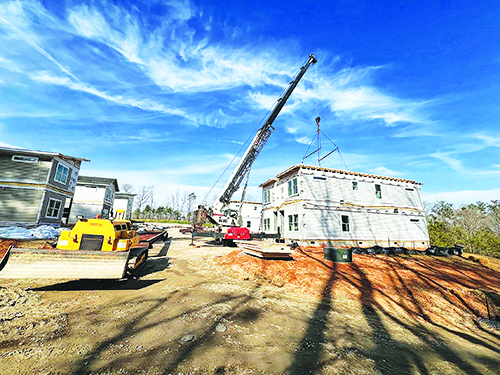
Courtesy of FourA Constructs
Outreach to Veterans
There are construction training opportunities that are not specifically modular-focused, but that modular manufacturers can take advantage of, too.
One such opportunity is through the Tunnel to Towers Foundation (T2T.org). Its mission is to help veterans and first responders by providing mortgage-free homes or building specially adapted smart homes for that population.
The organization also helps with employment via an employment team that is “constantly meeting with employers who are vet-friendly and vet-empathetic,” says Constance Barry, T2T’s senior director of national case management network. “Many of our veterans are looking for construction trade jobs like welding and HVAC since they have those skill sets already,” she says.
T2T does not do the training itself but rather partners with other training programs to train veterans. For instance, there are 131 veterans living at the veterans’ village it has built in Houston, Texas and many are looking for opportunities. “If there is a modular manufacturer in Houston looking for someone to work for them, they could have access to those residents. Reach out to us on our website.”
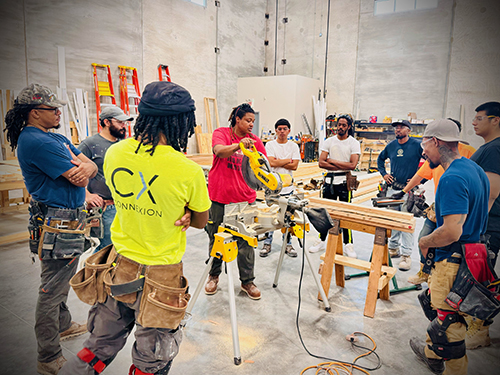
Credit: Courtesy of Inherent L3C
Make the Company Attractive
If you need employees quickly, the lowest hanging fruit is often your own workforce. But the construction industry has an issue with high turnover rate (sometimes called “churn”). According to Zippia statistics, the construction industry turnover rate is about 65%. The national average for annual turnover is about 47%. Turnover is expensive and disruptive.
According to the Society for Human Resource Management, employers will need to spend the equivalent of six to nine months of an employee’s salary to find and train their replacement. That means an employee salaried at $60,000 will cost the company anywhere from $30,000 to $45,000 to hire and train a replacement.
To combat churn, focus on attraction and retention. “One thing that’s important is thinking about your business and making it attractive to bring people in,” says John Colucci, Vice President of Sales and Marketing for Westchester Modular Homes in Wingdale, N.Y.
While Westchester Modular has found success by being employee-owned, via an Employee Stock Ownership Plan, Colucci knows that’s not for everyone. He does suggest that things like flexible work hours — “to the extent that it doesn’t make you less productive on the production line” — might work in some departments. He also suggests offering benefits such as health and even remote work when possible. “More [businesses] should focus on what they can do to retain employees instead of having them hop from factory to factory,” he says.
DPR Construction (DPR), a national commercial contracting and construction management firm based in Redwood City, California, combats turnover with a team dedicated solely to attracting talent in and outside of the industry for both craft and administration roles. DPR also has prefab assembly facilities to make components such as exterior and interior wall panels, prefabricated bathroom pods and electrical rough-ins.
“Having a team who truly believes in DPR’s purpose and can effectively communicate why a career with DPR is the right choice has been a huge game changer for us,” says Angie Weyant, National Craft People Practices Leader.
What attracts employees also helps with employee retention. Weyant says every DPR employee is paired with a coach who shares responsibility for their growth and development. The company also offers a full suite of benefits — from holiday pay to family planning aid, from education assistance, health benefits, to retirement packages — which Weyant says, “set a new bar in the industry. We know our employees, regardless of role, want to work in a place where they feel psychologically safe and supported. This all ties back to our mission, vision and purpose, as well as our point of view — respect the individual.”
Since raising the bar on benefits, Weyant says DPR has seen an increase in job applications. “If you treat your employees well,” she adds, “they’re more inclined to encourage their networks of family and friends to join the team. It’s a very family-oriented culture — it’s not uncommon for us to have multiple generations of families.”
While good benefits can help attract and retain employees, you still must attract the right employees. “Bringing in the wrong people leads to high turnover,” says Clifton Dial of Dial Ventures, based in southeastern North Carolina, who does leadership training and consulting for a variety of industries, including modular housing. He lays some of the blame on human resources departments that don’t know the process or have a deep understanding of what an offsite factory does. HR casts a wide net, hires the wrong people, and wastes money for the company.
Dial focuses on training people in HR to hire for quality and not quantity, to slow down the interview process and develop questionnaires to see if candidates are even worth consideration in the first place. He believes an ideal candidate for a job in offsite construction might be someone with a manufacturing mindset, rather than one with a deep construction background. “Framing, laying floors, installing windows and doors, roofing — all those things can be taught if you can seek out a person that has the right mindset to understand this is manufacturing more than it is construction.”
He says good modular companies are reaching out to schools, and creating cross-community relationships, “but not enough of them have HR departments that know exactly what the company does.”
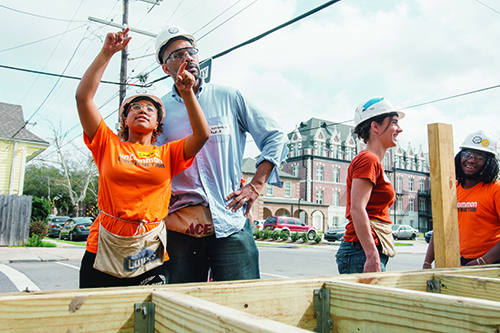
Credit: Courtesy of unCommon Construction
Stacey Freed is a freelance writer and editor based in Pittsford, New York. She focuses on construction, remodeling, real estate, sustainability and wellness.


